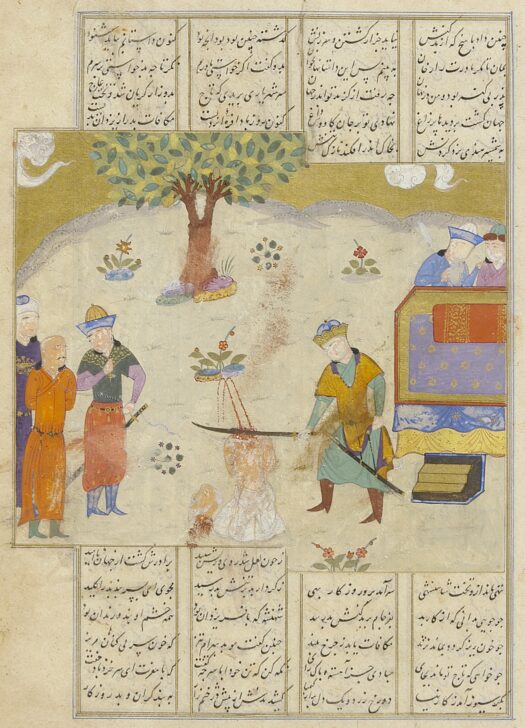Kai Khusrau Slays Afrasiyab and Garsiwaz, from the Shahnama of Firdausi
Iranian

Description
After Shah Kai Khusrau defeated Shida (in the previous scene, 1963/1.57), the Iranian and Turanian armies clashed repeatedly in furious battles, until the invincible Iranians captured Afrasiyab’s capital city. Afrasiyab escaped across the sea and wandered in hiding for many years, but his pursuers discovered him at last in a remote mountain cave. To entice him out from his hiding place, Kai Khusrau brought as bait Afrasiyab’s brother Garsiwaz—the villain who had originally betrayed Khusrau’s father Siyawush. When Afrasiyab emerged from his cave, Khusrau took his final vengeance.
With Indian sword
He smote Afrasiyab upon the neck,
Then flung upon the dust the swarthy form,
Whose ears and hoary beard were red with blood,
While Garsiwaz his brother lost all hope. . . .
The cheeks of Garsiwaz were wan, his heart
Was full of trouble for Afrasiyab.
They dragged him from the jailors shamefully
In heavy bonds, on that his evil day,
Begirt with guards and executioners
As such a noted miscreant deserved.
When in sad plight he came before Khusrau,
With tears of blood upon his livid cheeks,
The Shah, the king of kings, . . .
… called an executioner who came
With trenchant sword unsheathed, and cruel heart,
And clave the chief asunder to the waist
While all the soldiers’ hearts were terror-stricken.
Warner, IV, 268–69
The artist has chosen to depict the moment when Kai Khusrau personally beheads Afrasiyab and blood spurts forth from the headless corpse. Garsiwaz is shown at left, in a long orange tunic, with his hands bound behind his back. To the right is Khusrau’s portable throne, a high-backed platform upholstered with luxurious Chinese brocades.
———
Maribeth Graybill, Senior Curator of Asian Art
Exhibited in "A Medieval Masterpiece from Baghdad: the Ann Arbor Shahnama"
August 14 through December 19, 2004
Subject Matter:
With Indian sword
He smote Afrasiyab upon the neck,
Then flung upon the dust the swarthy form,
Whose ears and hoary beard were red with blood,
While Garsiwaz his brother lost all hope. . . .
The cheeks of Garsiwaz were wan, his heart
Was full of trouble for Afrasiyab.
They dragged him from the jailors shamefully
In heavy bonds, on that his evil day,
Begirt with guards and executioners
As such a noted miscreant deserved.
When in sad plight he came before Khusrau,
With tears of blood upon his livid cheeks,
The Shah, the king of kings, . . .
… called an executioner who came
With trenchant sword unsheathed, and cruel heart,
And clave the chief asunder to the waist
While all the soldiers’ hearts were terror-stricken.
Physical Description:
This Persian miniature is attributed to the Shiraz and Timurid schools, ca. 1460. The painting is done in ink, opaque watercolor and gold leaf on paper. The scene, Kai Khusrau Slays Afrasiyab and Garsiwaz, is part of the Shahnama of Firdausi, the Persian book of kings.
Usage Rights:
If you are interested in using an image for a publication, please visit https://umma.umich.edu/request-image/ for more information and to fill out the online Image Rights and Reproductions Request Form.